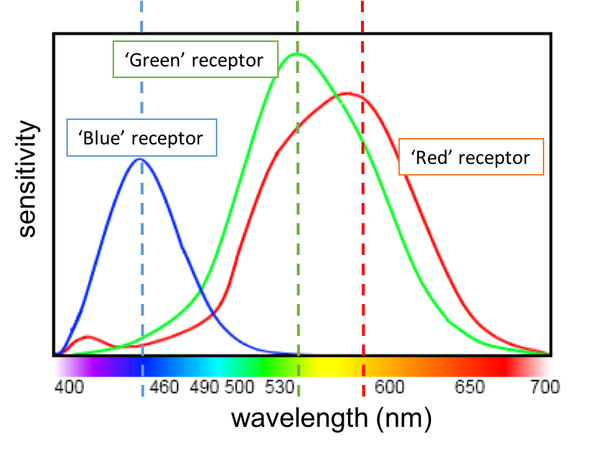How do we see color?
- Sunglass Science
- Jun 26, 2023
- 6 min read
Updated: Jul 31, 2023
Is the sky blue? Is the grass green? Are red roses really red?
No. And yes.
What you perceive as color is a miraculous combination of physics, biology, and psychology. And sunglasses can play a big role here. Let me explain.
In This Article:
The Electromagnetic Spectrum
Take a look at this red and blue ball, with a brown and white puppy sitting on green grass.

The greens are many different shades, as you can differentiate between all the blades of grass. The blues and reds go from lighter to darker shades, depending on the light shining on the different spots. Throughout the whole picture you are really seeing many hundreds of different shades of colors.
You see all those colors, but none of them actually exist. What you are seeing is different wavelengths of light being reflected off of those objects into your eyes. And then your brain decides what colors you are seeing. The fact that our eyes and brains can pick up the tiny differences between colors and interpret them to such a detailed degree is really astounding, especially when you keep in mind that the difference between colors is the minuscule difference between waves of energy.
This is the Electromagnetic Spectrum, with the visible light spectrum sliver highlighted.

Light is a form of energy that travels in electromagnetic waves. Light is both a particle and a wave, it has healing energy and harmful energy, and it is so fast that it travels the 24,901 miles around the earth 7.5 times in one second. We can see the wavelengths of light from around 400nm to 700nm. The lower the number, the shorter the wavelength and the higher the energy. You can see that the different frequencies make up certain colors, like blue, green, yellow, red. Violet is there but it isn’t really visible.
These frequencies come from different light sources, most notably the sun, but also from artificial light like lamps. They leave the light source as waves of energy and bounce off different objects until they hit our eyes.
But why are things different colors? Shouldn’t everything be white, since that is all the colors together?
Why Are Things Different Colors?
Different objects absorb different frequencies of light and reflect others. When red and green light are absorbed, but blue light is not, the only light bouncing off the object into our eyes is blue. So, we see blue even though that’s the only color that object does not accept.
Are red roses really red? No. We see the red light being reflected from them and interpret that as them being red.
The Role of Cones in Color Vision
Our eyes have color receptors called cones. Cones are a type of photoreceptor cell in the retina. They give us our color vision when they are stimulated by light hitting them. The retina has approximately 6 million cones.
There are only three types of cones as far as color is concerned. Blue, green, and red receptors. Those are the only colors our eyes can actually see. They make up the RGB structure used in screens, cameras, and light bulbs, as no other color is picked up the same way as these three. Our eyes cannot pick up yellow light.
Perception of Yellow and Other Colors
But we do see yellow and purple and brown and other colors. How does that happen?
Our brain makes them up. When our eyes receive a mix of green and red light coming from the same object, our brain interprets that as yellow. Same thing for brown, when the right mix of green, red, and blue hit together.
The same way a child learns to paint and mix colors, our eyes and brains construe the world around us. The cool thing about this is that our brains almost always get it right. When we make up yellow in our brains, we are usually seeing something reflect actual yellow light.
With one exception. Magenta (rose, purple etc.). That color doesn’t exist. It isn’t on the visible light spectrum. I explain here (LINK) how that happens.
The Sensitivity of Human Eyes and Color Perception
The eye does not respond equally to all wavelengths of light. When the visual response to daylight is plotted, it forms a bell curve with the maximum response in the green/yellow portion of the spectrum.

The way our eyes and brains work with this setup is fascinating. When the human eye looks at a colored object and a few minutes later at a similar colored object, it cannot tell us from memory whether the colors are different unless the difference is substantial.
The human eye does not function as an instrument for spectral analysis. That means that the same color sensation can be produced by different physical stimulus. Thus a mixture of red and green light of the proper intensities appears exactly the same as spectral yellow, although it does not contain light of the wavelengths corresponding to yellow, since we don't have yellow receptors.
The eye-brain mechanism of the human is incredibly sensitive. The human eye can differentiate about 10 million colors, but only by making a side-by-side comparison.
The human eye can only identify about 300 different colors from memory.
Any color sensation can be duplicated by mixing varying quantities of red, green and blue light. These colors, therefore, are known as "the additive primary colors".
Color Theory and Manipulation
These characteristics lead us towards the interesting world of color theory and how our eyes know how to mix and match colors, what colors have psychological effects on us, and how we can manipulate color to our benefit. That is all discussed here (LINK).
According to Dr. J. Trevor Woodhams, M.D., Chief of Surgery, Woodhams Eye Clinic, different cultures with their languages arrange what we call colors differently than English speakers. Russian speakers make the same red / pink and orange / brown distinctions as we would. But they will also make a further distinction between sinii and goluboi, which English speakers would simply call dark and light blue. To Russian speakers, these "colors" are as separate as red and pink, or orange and brown are to us. In Mandarin and Japanese, what we call "green" is considered a type of Blue!
Sunglasses and Color Perception
With that simplified science in mind, we can now understand that the color around us is not inherent. It is interpreted. And with sunglasses, we have tools that allow us to control and manipulate what light passes through the lens, in effect changing the world around us. We can alter and even eliminate colors.
For example, see this picture from Oakley

This is an accurate and excellent representation of what a brown lens can do. The right side is significantly more colorful, the colors are easier to tell apart, and the details are much clearer. But as we’ve seen before, the lens does not ‘add’ color. It can alter or eliminate colors. In fact, all the colors on the right side of the picture are present in the left side as well.
The difference the lens is making to this view is that the brown lens is boosting green and red light while blocking blue light and even eliminating some blue wavelengths. I explain this further in my post about brown lenses (LINK) and in other posts like .....
Most people think of sunglasses only as a way to reduce glare and protect their eyes from harmful light. Though those reasons are the primary reasons to wear shades to reduce harm and annoyance, the benefits that you can enjoy by picking the right lens for the right view cannot be understated. The world will look so much better, with enhanced colors and clarity, and you will end up picking up shades not to protect yourself but to enjoy your surroundings.
My discovery of this happened too fast to use as an example, but my wife really went through this gradual process of realization. At first she was skeptical of any real tech in the lenses I kept buying her, but as time went on she went from not caring which lens she wore to choosing different colors depending on the conditions, to choosing different shades and technologies within the same color.
I love that I can pick the colors of the trees and sky and when I walk to work each morning. I love that I can tune the world to fit my mood in a way a painter could never, as I can take the same canvas and change it every day.
That is the purpose of this website. To share the knowledge of sunglasses as tools to beautify our world just the way we like it.
Comments